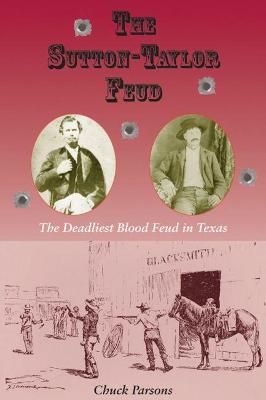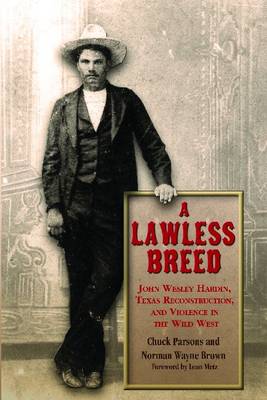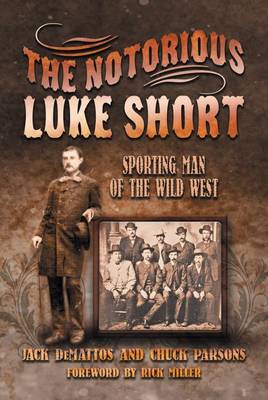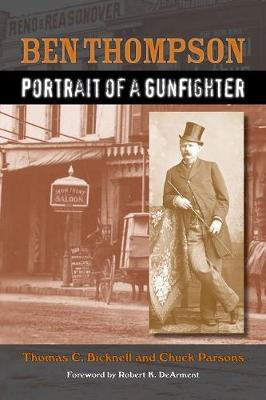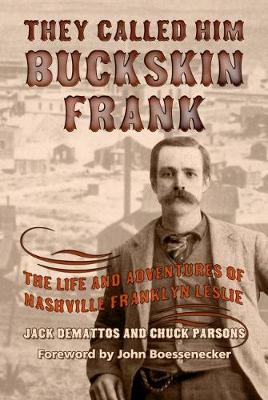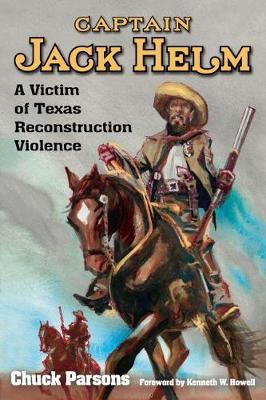A.C. Greene
1 primary work • 6 total works
Book 7
The Sutton-Taylor Feud of DeWitt, Gonzales, Karnes, and surrounding counties began shortly after the Civil War ended. The blood feud continued into the 1890s when the final court case was settled with a governmental pardon. Of all the Texas feuds, the one between the Sutton and Taylor forces lasted longer and covered more ground than any other. William E. Sutton was the only Sutton involved, but he had many friends to wage warfare against the large Taylor family. The causes are still shrouded in mystery and legend, as both sides argued they were just and right. In April 1868 Charles Taylor and James Sharp were shot down in Bastrop County, alleged horse thieves attempting to escape. During this period many men were killed ""while attempting to escape."" The killing on Christmas Eve 1868 of Buck Taylor and Dick Chisholm was perhaps the final spark that turned hard feelings into fighting with bullets and knives. William Sutton was involved in both killings. ""Who sheds a Taylor's blood, by a Taylor's hand must fall"" became a fact of life in South Texas. Violent acts between the two groups now followed. The military reacted against the killing of two of their soldiers in Mason County by Taylors. The State Police committed acts that were not condoned by their superiors in Austin. Mobs formed in Comanche County in retaliation for John Wesley Hardin's killing of a Brown County deputy sheriff. One mob ""liberated"" three prisoners from the DeWitt County jail, thoughtfully hanging them close to the cemetery for the convenience of their relatives. An ambush party killed James Cox, slashing his throat from ear to ear-as if the buckshot in him was not sufficient. A doctor and his son were called from their home and brutally shot down. Texas Rangers attempted to quell the violence, but when they were called away, the killing began again.
In this definitive study of the Sutton-Taylor Feud, Chuck Parsons demonstrates that the violence between the two sides was in the tradition of the family blood feud, similar to so many other nineteenth-century American feuds. His study is well augmented with numerous illustrations and appendices detailing the feudists, their attempts at treaties, and their victims.
In this definitive study of the Sutton-Taylor Feud, Chuck Parsons demonstrates that the violence between the two sides was in the tradition of the family blood feud, similar to so many other nineteenth-century American feuds. His study is well augmented with numerous illustrations and appendices detailing the feudists, their attempts at treaties, and their victims.
John Wesley Hardin! His name spread terror in much of Texas in the years following the Civil War as the most wanted fugitive with a $4,000 reward on his head. A Texas Ranger wrote that he killed men just to see them kick. Hardin began his killing career in the late 1860s and remained a wanted man until his capture in 1877 by Texas Rangers and Florida law officials. He certainly killed twenty men; some credited him with killing forty or more. After sixteen years in Huntsville prison he was pardoned by Governor Hogg. For a short while he avoided trouble and roamed westward, eventually establishing a home of sorts in wild and woolly El Paso as an attorney. He became embroiled in the dark side of that city and eventually lost his final gunfight to an El Paso constable, John Selman. Hardin was forty-two years old. Besides his reputation as the deadliest man with a six-gun, he left an autobiography in which he detailed many of the troubles of his life. In A Lawless Breed, Chuck Parsons and Norman Wayne Brown have meticulously examined his claims against available records to determine how much of his life story is true, and how much was only a half truth, or a complete lie. As a killer of up to forty men, Hardin obviously had psychological issues, which the authors probe and explain in laymen's terms. To Hardin, those three dozen or more killings were a result of being forced to defend his life, his honor, or to preserve his freedom against those who would rob or destroy him or his loved ones. Was he a combination freedom fighter/man-killer, or merely a blood-lust killer who became a national celebrity? This deeply researched biography of Hardin and his friends and family will remain the definitive study for years to come.
Luke Short perfected his skills as a gambler in locations that included Leadville, Tombstone, Dodge City, and Fort Worth. In 1883, in what became known as the "Dodge City War," he banded together with Wyatt Earp, Bat Masterson, and others to protect his ownership interests in the Long Branch Saloon - an event commemorated by the famous "Dodge City Peace Commission" photograph.
During his lifetime, Luke Short became one of the best known sporting men in the United States, and one of the wealthiest. The irony is that Luke Short is best remembered for being the winning gunfighter in two of the most celebrated showdowns in Old West history: the shootout with Charlie Storms in Tombstone, Arizona, and the showdown against Jim Courtright in Fort Worth, Texas. He would have hated that.
During his lifetime, Luke Short became one of the best known sporting men in the United States, and one of the wealthiest. The irony is that Luke Short is best remembered for being the winning gunfighter in two of the most celebrated showdowns in Old West history: the shootout with Charlie Storms in Tombstone, Arizona, and the showdown against Jim Courtright in Fort Worth, Texas. He would have hated that.
Ben Thompson was a remarkable man, and few Texans can claim to have crowded more excitement, danger, drama, and tragedy into their lives than he did. He was an Indian fighter, Texas Ranger, Confederate cavalryman, mercenary for a foreign emperor, hired gun for a railroad, an elected lawman, professional gambler, and the victor of numerous gunfights.
As a leading member of the Wild West's sporting element, Ben Thompson spent most of his life moving in the unsavory underbelly of the West: saloons, dance-houses, billiard halls, bordellos, and gambling dens. During these travels many of the Wild West's most famous icons-Wyatt Earp, Doc Holliday, Bat Masterson, Wild Bill Hickok, John Wesley Hardin, John Ringo, and Buffalo Bill Cody-became acquainted with Ben Thompson. Some of these men called him a friend; others considered him a deadly enemy.
In life and in death no one ever doubted Ben Thompson's courage; one Texas newspaperman asserted he was "perfectly fearless, a perfect lion in nature when aroused." This willingness to trust his life to his expertise with a pistol placed Thompson prominently among the western frontier's most flamboyant breed of men: gunfighters.
As a leading member of the Wild West's sporting element, Ben Thompson spent most of his life moving in the unsavory underbelly of the West: saloons, dance-houses, billiard halls, bordellos, and gambling dens. During these travels many of the Wild West's most famous icons-Wyatt Earp, Doc Holliday, Bat Masterson, Wild Bill Hickok, John Wesley Hardin, John Ringo, and Buffalo Bill Cody-became acquainted with Ben Thompson. Some of these men called him a friend; others considered him a deadly enemy.
In life and in death no one ever doubted Ben Thompson's courage; one Texas newspaperman asserted he was "perfectly fearless, a perfect lion in nature when aroused." This willingness to trust his life to his expertise with a pistol placed Thompson prominently among the western frontier's most flamboyant breed of men: gunfighters.
Nashville Franklyn "Buckskin Frank" Leslie was a man of mystery during his lifetime. His reputation has rested on two gunfights-both in storied Tombstone, Arizona-but he was much more than a deadly gunfighter. Jack DeMattos and Chuck Parsons have combined their research efforts to help solve the questions of where Leslie came from and how he died.
Leslie developed a reputation as a man to be left alone. Such notables as the Earps, Doc Holliday, and John Ringo wisely avoided confrontations with him. Leslie was a "lady killer" both figuratively and-in one celebrated incident-literally. Beyond his gunfighting legacy, DeMattos and Parsons also explore Leslie's scouting with General Crook on the Great Plains and his alleged service as a deputy for Wild Bill Hickok in Abilene, Kansas.
Leslie developed a reputation as a man to be left alone. Such notables as the Earps, Doc Holliday, and John Ringo wisely avoided confrontations with him. Leslie was a "lady killer" both figuratively and-in one celebrated incident-literally. Beyond his gunfighting legacy, DeMattos and Parsons also explore Leslie's scouting with General Crook on the Great Plains and his alleged service as a deputy for Wild Bill Hickok in Abilene, Kansas.
In Captain Jack Helm, Chuck Parsons explores the life of John Jackson "Jack" Helm, whose main claim to fame has been that he was a victim of man-killer John Wesley Hardin. That he was, but he was much more in his violence-filled lifetime during Reconstruction Texas. First as a deputy sheriff, then county sheriff, and finally captain of the notorious Texas State Police, he developed a reputation as a violent and ruthless man-hunter. He arrested many suspected lawbreakers, but often his prisoner was killed before reaching a jail for "attempting to escape." This horrific tendency ultimately brought about his downfall. Helm's aggressive enforcement of his version of "law and order" resulted in a deadly confrontation with two of his enemies in the midst of the Sutton-Taylor Feud.
